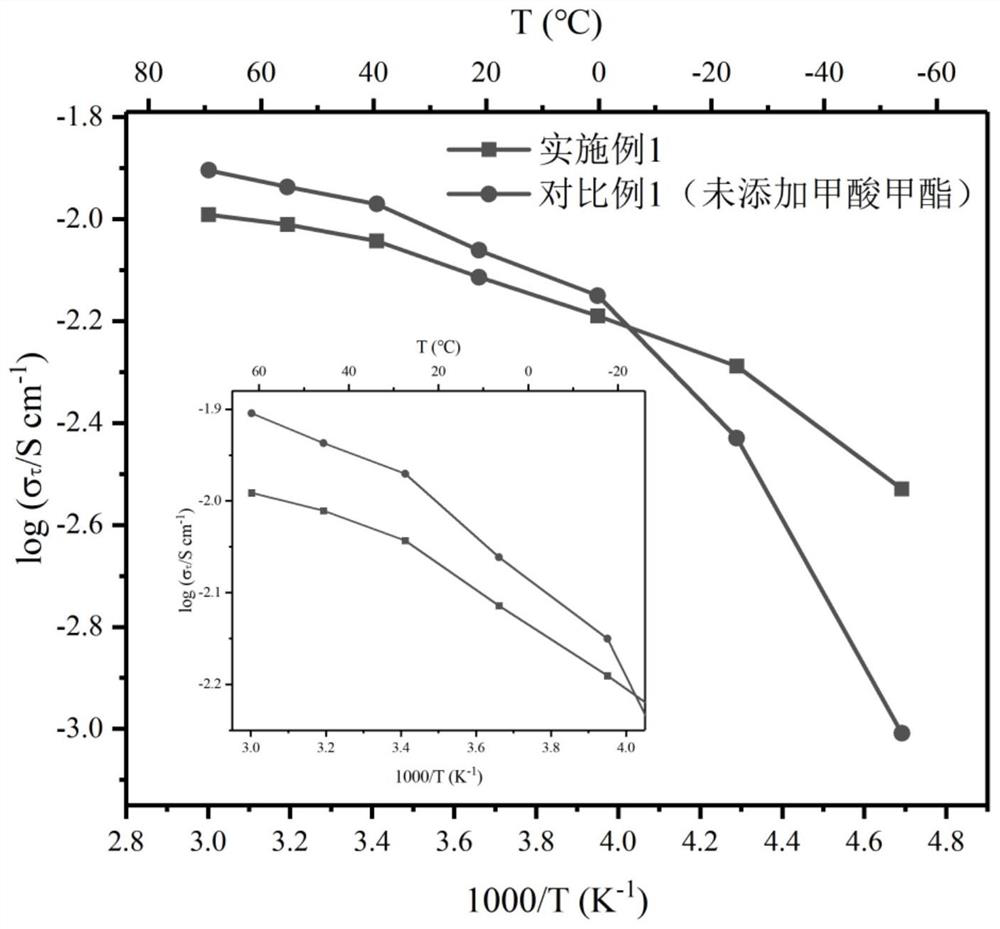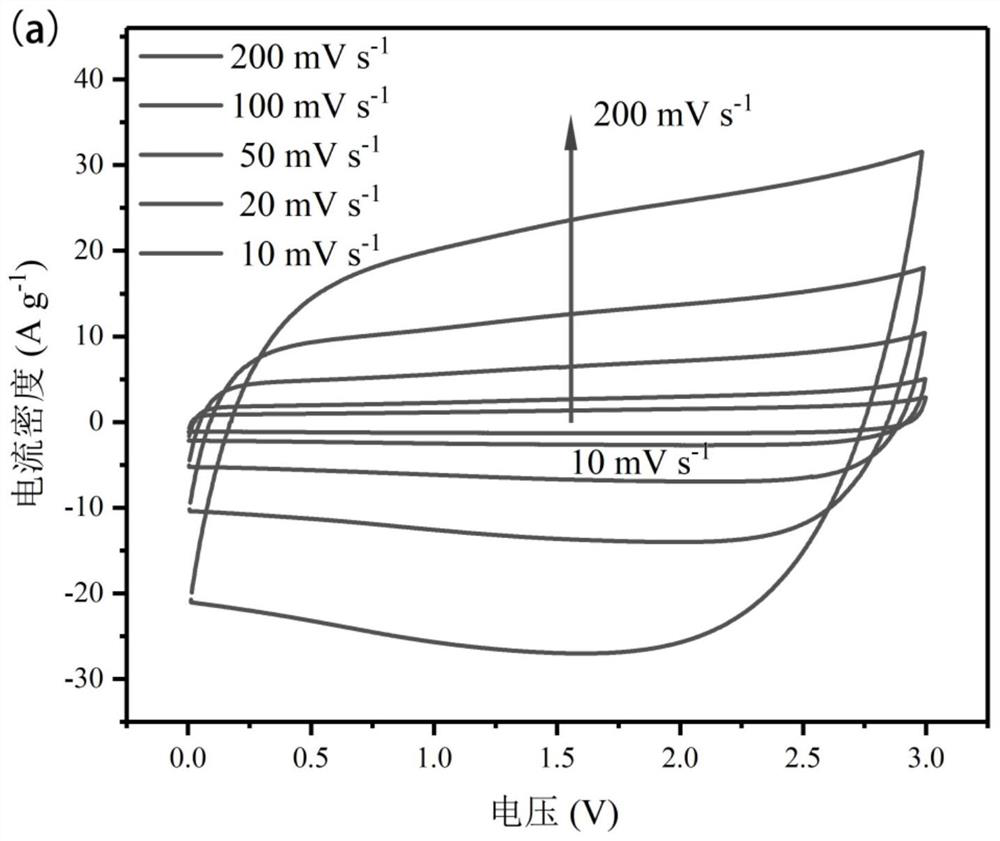Preparation method of low-temperature solid electrolyte and application of low-temperature solid electrolyte in low-temperature solid supercapacitor
A solid-state electrolyte and supercapacitor technology, used in the manufacture of hybrid/electric double-layer capacitors, hybrid capacitor electrolytes, etc., can solve the problems of poor performance, decreased electrolyte conductivity, high freezing point of organic solvents, low explosion hazard, and improved voltage window. , the effect of excellent electrochemical performance
- Summary
- Abstract
- Description
- Claims
- Application Information
AI Technical Summary
Problems solved by technology
Method used
Image
Examples
Embodiment 1
[0037] Preparation of Low Temperature Solid Electrolyte Membrane:
[0038] Step S1: Add 16ml of acetone to 2.4g of polyvinylidene fluoride-hexafluoropropylene PVDF-HFP particles, and fully dissolve it with magnetic stirring at 50°C to obtain a transparent viscous solution A;
[0039] Step S2: Mix 6ml of propylene carbonate, 12ml of acetonitrile and 12ml of methyl formate, add 6g of 1-ethyl-3-methylimidazolium tetrafluoroborate, and stir evenly at room temperature with magnetic force to obtain a clear and transparent solution B;
[0040] Step S3: Add 16ml of solution B obtained in step S2 to 16ml of solution A obtained in step S1, and mix well to obtain precursor solution C;
[0041] Step S4: coating the precursor solution C obtained in step S3 on a clean and smooth substrate, and drying naturally for 24 hours to obtain a low-temperature solid electrolyte membrane with a thickness of 20-100 um.
[0042] figure 1 The ionic conductivity figure of the solid electrolyte membrane ...
Embodiment 2
[0049] This embodiment uses solution A with different mass fractions.
[0050] Preparation of Low Temperature Solid Electrolyte Membrane:
[0051] Step S1: Add 24ml of acetone to 2.4g of polyvinylidene fluoride-hexafluoropropylene PVDF-HFP particles, and fully dissolve it with magnetic stirring at 50°C to obtain a transparent viscous solution A;
[0052] Step S2: Mix 6ml of propylene carbonate, 12ml of acetonitrile and 12ml of methyl formate, add 6g of 1-ethyl-3-methylimidazolium tetrafluoroborate, and stir evenly at room temperature with magnetic force to obtain a clear and transparent solution B;
[0053] Step S3: Add 16ml of solution B obtained in step S2 to 16ml of solution A obtained in step S1, and mix well to obtain precursor solution C;
[0054] Step S4: coating the precursor solution C obtained in step S3 on a clean and smooth substrate, and drying naturally for 24 hours to obtain a low-temperature solid electrolyte membrane with a thickness of 20-100 um.
[0055] T...
Embodiment 3
[0058] The present embodiment adopts different ratios of solvents propylene carbonate, acetonitrile, and methyl formate.
[0059] Preparation of Low Temperature Solid Electrolyte Membrane:
[0060] Step S1: Add 16ml of acetone to 2.4g of polyvinylidene fluoride-hexafluoropropylene PVDF-HFP particles, and fully dissolve it with magnetic stirring at 50°C to obtain a transparent viscous solution A;
[0061] Step S2: Mix 6ml of propylene carbonate, 6ml of acetonitrile and 6ml of methyl formate, add 3.6g of 1-ethyl-3-methylimidazolium tetrafluoroborate, and stir evenly at room temperature to obtain a clear and transparent solution B;
[0062] Step S3: Add 16ml of solution B obtained in step S2 to 16ml of solution A obtained in step S1, and mix well to obtain precursor solution C;
[0063] Step S4: coating the precursor solution C obtained in step S3 on a clean and smooth substrate, and drying naturally for 24 hours to obtain a low-temperature solid electrolyte membrane with a thic...
PUM
| Property | Measurement | Unit |
|---|---|---|
| quality score | aaaaa | aaaaa |
Abstract
Description
Claims
Application Information
 Login to View More
Login to View More - R&D
- Intellectual Property
- Life Sciences
- Materials
- Tech Scout
- Unparalleled Data Quality
- Higher Quality Content
- 60% Fewer Hallucinations
Browse by: Latest US Patents, China's latest patents, Technical Efficacy Thesaurus, Application Domain, Technology Topic, Popular Technical Reports.
© 2025 PatSnap. All rights reserved.Legal|Privacy policy|Modern Slavery Act Transparency Statement|Sitemap|About US| Contact US: help@patsnap.com



